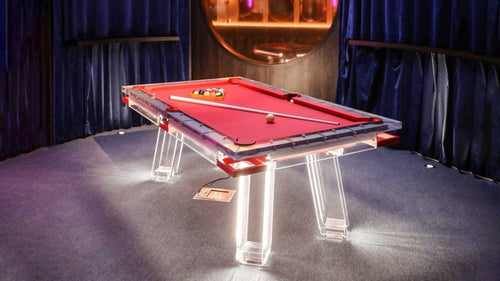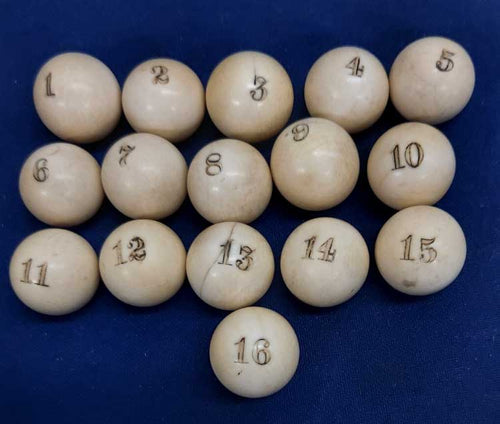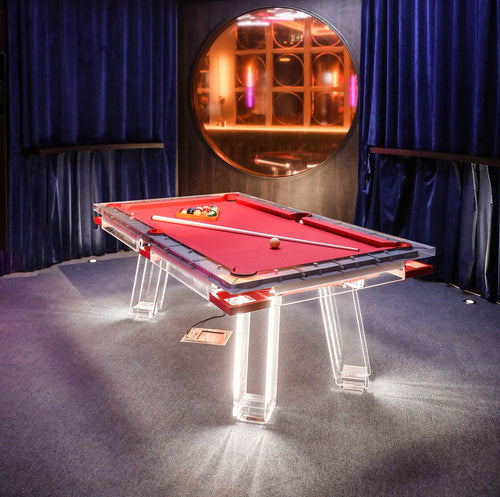Enjoy our modern designs
Among the various aiming techniques, the Shaft Aiming System stands out for its simplicity, effectiveness, and accuracy. This method utilizes the edges of your cue stick's shaft as visual guides to align shots, making it easier to pocket balls consistently.
In this comprehensive guide, we'll delve deep into the Shaft Aiming System, exploring how it works, how to apply it in different scenarios—including shots with English—and how it can transform your gameplay.
Why the Shaft Aiming System?
- Simplicity: The system is straightforward, making it easy to learn and apply.
- Accuracy: By using the edges of your cue shaft, you gain precise visual reference points.
- Versatility: Applicable to a wide range of shots, including those with varying angles and spins.
- Consistency: Helps develop muscle memory for more reliable shot execution.
Understanding the Basics
Key Concepts
- Cue Shaft Edges: The left and right edges of your cue stick's shaft are used as alignment guides.
- Contact Point: The exact point on the object ball where the cue ball must strike to send it into the pocket.
- Shot Line: The imaginary line along which your cue stick and cue ball travel to hit the object ball.
Fundamental Principles
- Edge Alignment: For cuts to the left, use the left edge of your shaft; for cuts to the right, use the right edge.
- Visual Connection: Align the appropriate edge of your shaft with the contact point on the object ball.
- Stepping Into the Shot: Approach the table with your shot line in mind, aligning your body and cue stick accordingly.
- Smooth Execution: Maintain a steady stroke along the established line to ensure accuracy.
Step-by-Step Guide to Shaft Aiming
Assess the Shot
- Determine the Cut Direction: Is the shot a cut to the left or right?
- Identify the Contact Point: Visualize where on the object ball the cue ball needs to make contact.
Align the Shaft Edge
-
For Cuts to the Left:
- Use the left edge of your shaft.
- Align it with the contact point on the object ball.
-
For Cuts to the Right:
- Use the right edge of your shaft.
- Align it with the contact point on the object ball.
Step Into the Shot
- Visual Alignment: As you approach the table, maintain focus on the alignment between your shaft edge and the contact point.
- Body Position: Align your body along the shot line, ensuring a comfortable and stable stance.
Execute the Shot
- Smooth Stroke: Deliver a controlled and consistent stroke along the established line.
- Follow Through: Maintain your form after the shot to ensure the cue stick stays on the intended path.
Practical Examples
Example 1: Cutting a Ball to the Left
Scenario: You need to cut the 7-ball into the corner pocket on your left.
-
Alignment:
- Use the left edge of your shaft.
- Align it with the contact point on the 7-ball.
-
Execution:
- Step into the shot, keeping your eye along the left shaft edge.
- Deliver a smooth stroke along the shot line.
- Result: The 7-ball is pocketed in the left corner.
Example 2: Cutting a Ball to the Right
Scenario: You need to cut the 14-ball into the corner pocket on your right.
-
Alignment:
- Use the right edge of your shaft.
- Align it with the contact point on the 14-ball.
-
Execution:
- Step into the shot, focusing along the right shaft edge.
- Execute a smooth stroke.
- Result: The 14-ball is pocketed in the right corner.
Example 3: Slight Angle Shots
Scenario: You have a slight angle, almost straight in.
-
Alignment:
- Even with minimal angles, still use the shaft edge.
- Choose the appropriate edge based on the cut direction.
-
Execution:
- Align and execute as usual.
- Result: The ball is pocketed with precision.
Advanced Applications
Using English (Spin)
Challenge: Aiming with English (side spin) can be tricky. The Shaft Aiming System simplifies this by adjusting the shaft edge you use.
Outside English
- Definition: Applying spin on the side of the cue ball away from the direction of the cut.
-
Alignment:
- Use the standard shaft edge for the cut direction.
- Align the shaft edge with the contact point, considering the deflection caused by the spin.
-
Execution:
- Apply the desired amount of side spin.
- Maintain your alignment and stroke smoothly.
- Result: Accurate shots even with outside English.
Inside English
- Definition: Applying spin on the side of the cue ball towards the direction of the cut.
-
Adjustment:
- Reverse the shaft edge you would normally use.
- For cuts to the left with inside English, use the right edge of your shaft.
- For cuts to the right with inside English, use the left edge of your shaft.
-
Execution:
- Align accordingly and apply the inside English.
- Execute with a smooth stroke.
- Result: Effective inside English shots without guesswork.
Examples with English
Outside English Example
- Scenario: Need to cut the ball to the left with right-hand (outside) English.
-
Alignment:
- Use the left edge of your shaft (standard for left cuts).
- Align with the contact point, accounting for slight deflection.
-
Execution:
- Apply right-hand spin.
- Stroke smoothly along the shot line.
- Result: The ball is pocketed, and the cue ball follows the desired path.
Inside English Example
- Scenario: Need to cut the ball to the left with left-hand (inside) English.
-
Alignment:
- Use the right edge of your shaft (reverse of standard for left cuts).
- Align with the contact point.
-
Execution:
- Apply left-hand spin.
- Maintain alignment and execute the stroke.
- Result: The ball is pocketed, and the cue ball responds to the inside English.
Tips for Mastery
- Consistency is Key: Ensure your stroke and alignment are consistent for every shot.
- Practice Different Angles: Work on shots ranging from slight cuts to extreme angles (up to 70 degrees).
-
Adjust for Your Equipment:
- Low-Deflection Shafts: The system works best with low-deflection shafts.
- High-Deflection Shafts: May require slight adjustments; practice to understand the differences.
- Smooth Execution: A fluid stroke is essential. Avoid jerky movements that can throw off your aim.
- Use an Open Bridge When Possible: Allows for better visibility of the shaft and alignment.
- Stay Relaxed: Tension can affect your stroke. Keep your grip and body relaxed.
Common Mistakes and How to Avoid Them
- Not Accounting for Deflection: Especially when using English, be aware of how your cue and spin affect the cue ball's path.
- Inconsistent Alignment: Always align the correct shaft edge with the contact point based on the cut direction and spin.
- Rushing the Shot: Take your time to set up the shot properly. Hasty execution can lead to errors.
-
Ignoring Fundamentals:
- Stance: Ensure your stance is stable and aligned with the shot.
- Grip: Maintain a relaxed but firm grip.
- Follow-Through: Complete your stroke; pulling back prematurely can affect accuracy.
Frequently Asked Questions
Q: Does the Shaft Aiming System work for extreme cut shots?
A: Yes, it works effectively for cuts up to about 70 degrees. For cuts beyond that, the method may be less precise, and additional practice is recommended.
Q: Can I use this system with any cue stick?
A: While the system works best with low-deflection shafts, you can adapt it to your cue stick. Be aware that high-deflection shafts may require adjustments due to increased cue ball deflection when using English.
Q: How does the system handle shots with English on a high-deflection shaft?
A: You'll need to compensate more for deflection. Practice is essential to understand how your specific cue reacts to spin.
In Conclusion
The Shaft Aiming System offers a simple yet powerful way to enhance your aiming skills in pool. By leveraging the edges of your cue shaft as visual guides, you can achieve greater accuracy and consistency across a wide range of shots—even when applying English.
Remember, no aiming system is a magic bullet. Solid fundamentals are crucial. Ensure your stroke, alignment, and execution are consistent, and practice diligently. With time and effort, the Shaft Aiming System can become a valuable tool in your pool arsenal, helping you pocket balls with confidence and precision.


















